1. Introduction
A common dilemma faced by many when setting up their kitchen is whether to opt for a microwave, OTG or convection microwave oven. A lack of information on the differences between them often makes the decision even more difficult. Well, each of them is meant for a specific purpose and comes with its own pros and cons in terms of speed, energy efficiency, the kind of cooking it is suited for, the space it takes up and the hassle of cleaning it.
This post takes a deeper look at each of these alternatives, their pros and cons, and highlights key aspects to keep in mind to help you to choose one that’s optimally suited for your needs.
This post covers 2 main topics:
- Microwave vs OTG vs convection oven vs built-in oven
- 5 factors to keep in mind when choosing a microwave oven
2. Difference between a microwave, OTG and convection microwave oven
2.1 Two ways to heat food
Simply put, there are 2 ways these products heat food:
a) Using radiation
In this method, food is heated by the heat radiations emitted from electrically heated coils; hence the food heats “outside-in”. Heating is slow and inefficient, as the area around the food also gets heated. This method of heating is used in baking and grilling.
b) Using microwaves
A microwave is a high-frequency electromagnetic wave (300 MHz-300 GHz) that penetrates food easily and heats it by making the food molecules vibrate more quickly. As microwaves go right through the food, the food heats “inside-out” in a matter of minutes. Microwaves are energy efficient as all the energy from the microwaves is used to heat the food while keeping the area around the food relatively cool. You can neither bake nor grill anything using microwaves.
2.2 Microwave vs OTG vs Convection microwave oven vs Built-in oven
Different combinations of the above 2 methods of heating yield 4 options:
2.2.1 Microwave
A microwave (or solo microwave) is a simple, efficient, relatively inexpensive product that uses only microwaves for heating food. At the core, it has a magnetron that uses electricity to generate microwaves (2450MHz) that bounce off the inner walls and penetrate the food to heat it.
A solo microwave is ideal if you don’t have any baking needs, and just need an appliance for quickly heating food
Keep in mind though, that you cannot have any metallic objects inside a microwave, as it could lead to a fire. A microwave also doesn’t have any accurate temperature control; you can only change its power levels. Some brands may provide a grill function in their solo models by adding a coil on the upper part of the microwave.
- Pros – It heats food quickly. It is a relatively inexpensive product.
- Cons – It cannot be used for baking and grilling.
If you are looking to bake, then you have to select one from the next 3 options.
2.2.2 Built-in oven
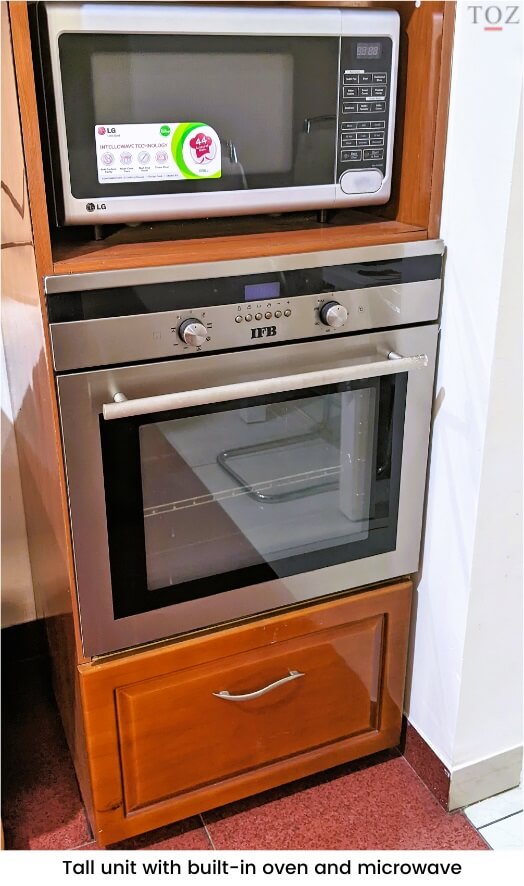
This is a relatively large oven that uses only radiation for heating. It is ideally suited for professionals, baking enthusiasts or those who need to bake/grill in large quantities. It has several racks installed, so you can slide in multiple trays one on top of the other and bake multiple batches of bread or cookies together.
- Pros – Quality of baking/grilling is impeccable.
- Cons – It is expensive, inefficient, takes up more space and a real pain to clean.
2.2.3 Convention microwave
A convection microwave is a mix of a solo microwave and an oven; it can be used for heating, baking and grilling. In addition to the microwave function, it has 2 sets of coils that can be heated electrically – one on top and one behind. When running in convection mode for baking, an internal fan distributes heat uniformly inside the microwave oven.
- Pros – You get a microwave, oven and grill in a single appliance, thus saving you on space and cost. It is also more energy efficient than an OTG or built-in oven.
- Cons – Grilling quality is not even close to that of a built-in oven or OTG. Baking quality is quite good for the average person but not good enough for an enthusiast/professional. It does not have any racks, so you cannot bake multiple batches in one go. A convection microwave is more expensive than a solo microwave or an OTG.
2.2.4 OTG
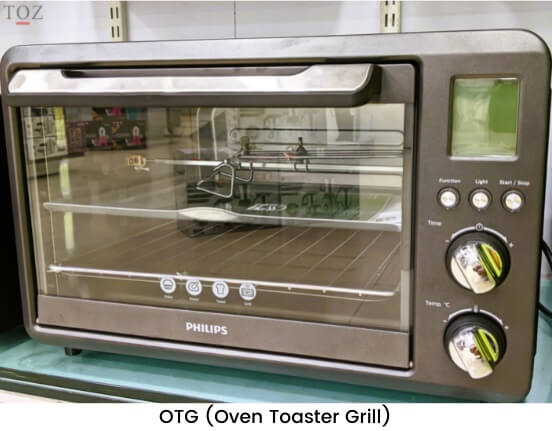
An OTG (oven toaster grill) is a portable oven that uses only radiation for baking and grilling. It has fewer racks than a built-in oven.
- Pros – An OTG is quite inexpensive. Quality of baking/grilling is better than that of a convection microwave (but not as good as that of a built-in oven).
- Cons – It is energy inefficient and takes time to heat up. It also takes up precious kitchen countertop space as it’s an appliance most people buy in addition to a microwave. (Microwaves have practically become a necessity today, given their ability to heat food quickly).
Some baked dishes require a consistent temperature from all sides; so it’s crucial that the oven doors seal well with no major heat leakages when closed.
It’s common to be enamoured by pictures of beautiful kitchens that you see floating all over the internet. If you look carefully, you will notice that a lot of them have a built-in oven in addition to a microwave. That’s because a lot of them are modelled based on western kitchen needs. While built-in ovens are common in the west, they aren’t a necessity as such for all Indian kitchens (unless you are a baking or grilling enthusiast). A microwave, on the other hand, has become a necessity these days. So people who like to grill or bake occasionally typically opt for a convection microwave or additionally buy an OTG (if they have the extra space).
3. 5 factors to keep in mind when choosing a microwave oven
Here are 5 things you must keep in mind when buying a microwave, be it a solo or a convection model.
3.1 Power
Buy a model that has a power rating of atleast 900W. Models below 900W take a long time to heat and sometimes don’t heat food evenly.
3.2 Capacity
Microwave ovens are available in capacities varying from 19 litres to 32 litres. Convection models are generally more than 25 litres as they are also used for grilling meat (there should be enough space for the meat to be rotated by the rotisserie).
The What-if trap:
We often buy a larger size of an appliance to account for a one-off case when we may need it (say, when we want to host a party). The problem with this approach is that not only do you end up spending more money on the appliance and subsequent electricity bills, but the larger appliance also takes up precious countertop or storage space that could have been otherwise better utilised. I call this the “what-if” trap. To avoid this trap, try to be as objective as possible when making such purchase decisions. Think about what size or capacity you will need 95% of the time and decide accordingly.
Personal experience:
I had fallen prey to the what-if trap when I bought my first microwave. Impressed by its many features, I ended up buying a premium 32-litre convection model. Over the next 9 years, we used the grill a total of 3 times and not once did we bake anything. All we needed was a simple microwave to re-heat food. I was more pragmatic for my second purchase – a 20-litre solo microwave with a grill.
3.3 Position of handle
Microwave doors can be hinged on the side or below. Depending on where you place your microwave, you may find one better than the other. For example, if the microwave is against a wall on the right, a door hinged at the bottom would provide easier access from the sides.
3.4 Warranty
The magnetron is the most critical and expensive part of the microwave. It is the device that generates the microwaves for heating food. Buy a model that gives you atleast 4 years warranty on the magnetron.
3.5 Other features
Microwaves today come with hundreds of autocook functions that can help you cook several dishes with lesser effort. These functions are basically customised programs that automatically vary the power levels of the microwave to cook specific dishes. While some of these autocook programs are useful, I have seen people seldom use them and prefer to cook using traditional means instead. Hence, I see it more as a nice-to-have than a deciding factor when choosing a microwave. I suggest you objectively think through how useful these might be to you and then take a call.
4. Conclusion
With the plethora of options for microwaves and ovens available today, it’s easy to get lost, and zeroing-in on one can be quite a task. Staying objective is paramount – putting your lifestyle, kitchen layout and cooking preferences on top. With the above pointers in mind, you should be better equipped to assess your options and select one that is optimally suited to your needs.
Have questions or queries?
There are some pertinent queries that other readers have asked in the comments section at the end of this page; do go through them to see if any of them resonate with you. If you have a different question, feel free to mention it there; I will do my best to answer it. Please allow a few days for me to respond. If I (or any other reader) can answer it, then good. If not, atleast it will be something for the next reader to keep in mind. In case you have any learnings or experience to share, do mention it there for the benefit of other readers.
In case you are planning to design your kitchen, you can refer my post on designing a kitchen that details a structured approach on how to going about it. It takes a deeper look at design and material considerations you must keep in mind for different kitchen components like cabinets, shutters, drawers, countertop, fittings, etc.
If you are looking to buy new kitchen appliances, you can refer to my posts on:
- choosing the right chimney, hob and exhaust fan for your kitchen – This looks at aspects to consider when assessing options, filtering out the marketing gimmicks and focussing on the factors that really matter, comparing kitchen chimneys with exhaust fans.
- A practical guide to buying a refrigerator – 9 key factors to keep in mind when selecting one.
- Choosing the right washing machine
- Dishwasher buying guide – The right one can really help get rid of a lot of headache.
In case you are planning on doing up other parts of your house as well, you could refer to some of my other posts:
- 4 factors to consider when designing or selecting a wardrobe – this delves into factors like build material options, pros and cons of different types of shutters, designing wardrobe internals (shelves, drawers, fittings), buying readymade versus getting it custom-made.
Share this post:

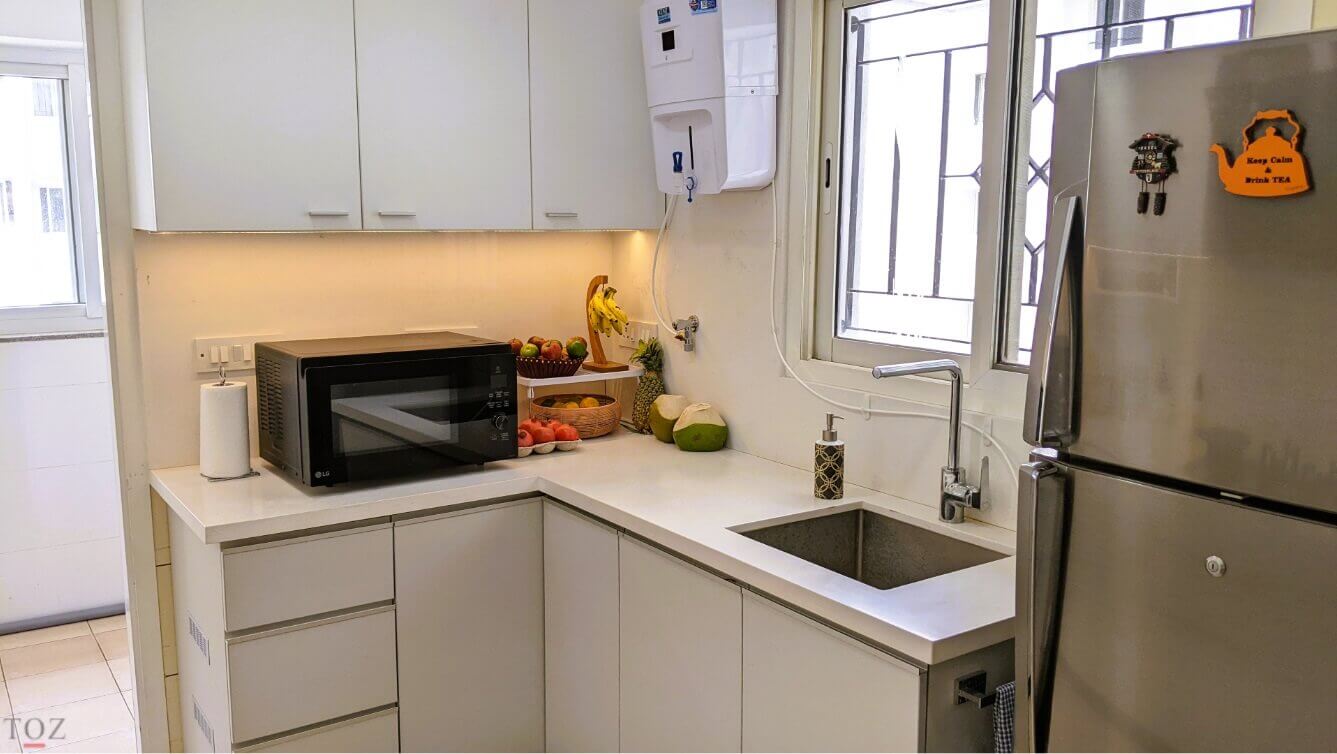
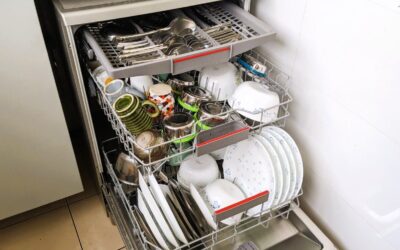
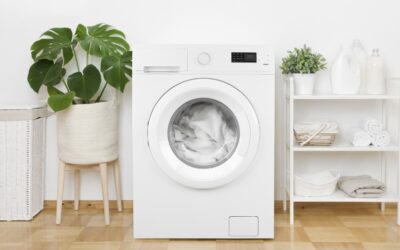
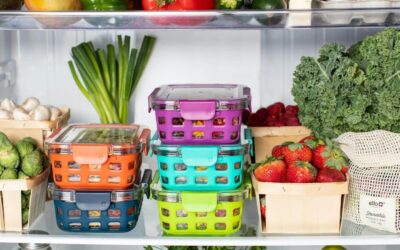

Hi Pradip, I have no experience with OTG, but I often use regular oven. Regular oven can have temperature spread from 0 to 250 Celsius. I often used it from pizza (220 – 250 Celsius) or for chicken (170-180 Celsius). Do you please know what are the temperature limitations of OTG? Thank you.
OTG’s come in mainly 2 temperature ranges – the first one is 0-230 celsius, while the second one is 0-250 celsius.
Earlier, the maximum temperature of OTGs used to be a much lower than that of regular ovens, but the gaps have come down now. These days most regular (built-in) ovens for home have a temperature range of either 90-250 degrees or the 90-280 celsius.
If you are already using a regular oven, you might find it a bit hard to switch to an OTG, especially if you grill often. My mom has an regular oven as she bakes a lot. It’s 14 years old and the grilling quality is simply unmatched. If we are making Tandoori chicken (a popular grilled dish here in India), the level of charring on the meat is just right. Somehow the OTG we had was never able to match that, it was either under-charred or over-charred.
Thank you Pradip! Very appreciate your website!
Great article, did make me stop and revisit my choices and utility post buying. A few additional questions/considerations.
– comparison to an air fryer. I’ve recently started using one and understand it’s quite similar to a smaller convenient sized oven that’s suited for certain types of Foods. Thought, or feedback based on your research?
– great point about warranty on the magnetron. How do I find that, is that located somewhere eight in the fine print. Is it common for most brands to offer it or only some ( perhaps the expensive ones).
– something I’ve noticed – if you have the time and an oven, some foods like breads, leftover pizza, fried snacks eg samosas are much better heated in a regular oven at low heat (150C) compared to microwave that makes it almost in edible.
Cheers!
I haven’t researched air-fryers as yet. I just know they use convection and primarily focused towards frying with minimal oil. Since the prime mode of heating is hot air, I’m not sure if they can be used for baking. Ovens on the other hand are well-suited suited for baking, as baking primarily requires radiation heat, with convection acting more as an addon to maintain a uniform temperature.
Warranty on magnetron is not restricted to the premium brands/models, several mid-range ones also have it. The only difference is that the premium ones don’t go all out bluntly advertising it. You will find it mentioned in the warranty part of their documentation. If you go to a physical store, the salesperson will definitely mention if a model has it.
Yes, I agree, you are much better off heating foods like pizza, bread, snacks in an oven. The problem with microwave heating, is that it heats food “inside-out”, as the waves go deep into the food. The temperatures spikes very quickly, and this often leads to the food item losing a lot of its moisture, and consequently it’s texture as well. This is especially true when re-heating, when the moisture levels are already lower. Ovens on the other hand, heat food using radiation which gradually heats the food “outside-in”. Moisture levels and texture remain intact and the food tastes better.
It’s a very helpful article. Merely know that they use convection and are primarily concerned with frying foods using little to no oil. Hot air is the primary heating method,
Thanks for this article Pradeep. Very useful. I have a question – I have LG 21 L Mocrowave Oven (MC2146BV ). I want to keep it inside the cabinet in my tall unit in kitchen. Is it advisable? Or should I place it on counter top? Whats your opinion on this?
Yes, you can keep your microwave oven inside the cabinet in your tall unit. Just keep an eye out for the vents in your oven.
Microwave ovens will have vents to get rid of excess heat. The placement of these vents varies by model and brand. They can be on top, the sides, back or a combination of these. You need to ensure that you leave a gap between the oven and the walls of the unit. The gap is usually about 2 inches – it will be mentioned in the manual.